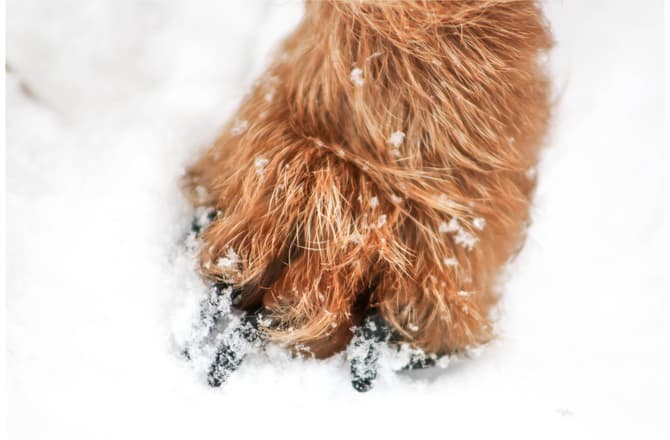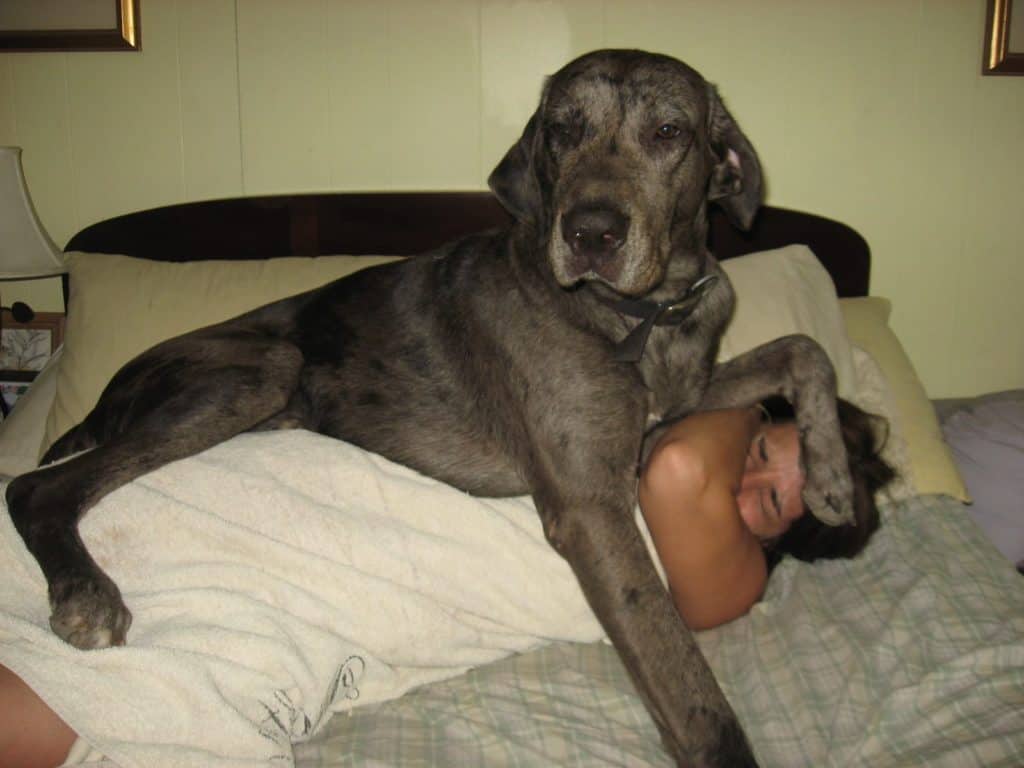
Caring For Your Dogs Paws in Extreme Weather is important, find out how in this article.
Winter can be merciless on our canine’s paw pads. Presented to the components and dangerous toxic chemicals, the paw pads are in danger of drying, splitting, injury, frostbite, and compound consumes.
Fortunately, there are a few things you can do that can help keep your pooch’s paws upbeat and sound this winter.
Numerous protective balms are available to help secure your pooch’s paws, and even some human items can work. Do your own research to see what is best for your dog. When you discover the balm that you like, take these steps.
Prepare your dog’s paws for winter
Before using the balm, make sure the paw is ready. Good grooming is essential for healthy winter feet. If your dog has long hair use a clipper (beard trimmer with the shortest plastic guard equipped works well) to keep the hair between the paw pads short so that it is even with the pad.
Trim the hair around the paws particularly in the event that they have a great deal of feathering to ensure none of the hair comes into contact with the ground.
This will help keep ice balls from shaping between and around the paw pads which can be agonizing and result in injury. It additionally makes it less demanding to apply the balm to the pads.
Keeping the nails cut is critical all year however considerably more so in the winter on the grounds that long nails constrain the paw to spread out and make it more probable that snow and ice will gather between the paw pads.
Apply a thin even layer of analgesic just before going out for a stormy walk. After the walk wipes your pooch’s paws with a warm washcloth to evacuate snow, ice, and ice melt. At that point apply another layer of balm to mitigate any bothering and to shield them from drying out.
Bag Balm can be found in most medication stores and pet stores. In the event that you can’t discover Bag Balm, Vaseline is an adequate option.
Preventing Paw Pad Injuries
One of the greatest dangers to healthy paw pads is the salt used to dissolve ice on driveways, streets, and walkways. Drawn out contact can prompt chemical burns on canine paws.
In the event that your puppy is limping by the end of a walk, deicing items might hurt his feet.
Endeavor to keep your pooch off the salty walkway (think grass or snow) at whatever point conceivable. It might be worth getting some pet insurance.
Another danger from deicers is ingestion. Puppies may lick their paws or your boots and ingest deicing salts.
To keep your canine from ingesting deicing salts, keep a shallow bowl of warm water and a fabric close to the door to your home with the goal that you can wipe your boots and your puppy’s paws when returning inside.
Another basic reason for sore paws amid the virus winter months is the ice balls which shape between the pads and toes of the furry footed puppy.
To reduce the risk of ice balls, keep inter-pad hair trimmed neatly and short during the winter months.
Not exclusively can furry feet add to the festering of ice balls on the feet, paw hair can hold a great deal of those awful deicing salts. On the off chance that your pooch has shaggy feet, trim them all through the winter.
Pooches left wide open to the harsh elements for significant amounts of time are likewise in danger of frostbite on paws and hypothermia. It isn’t advised that dogs spend too much time in the cold open.
In winter, short strolls are preferable for your pooch over a solitary long walk.
Protecting your dog’s paws
There are numerous items intended to secure pooch paw pads amid the winter month, from pet safe deicing items to defensive waxes and puppy booties.
Safe Paw is a typical pet-accommodating deicer, yet sand, little stones, and kitty litter (non-clumping) are additionally choices for deicing while at the same time shielding your canine’s pads from damage and chemical burns.
Safe Paw Ice Melter- –Available here on Amazon.
Musher’s Secret is a standout among the most mainstream paw waxes.
Paw wax is applied to the pads of the feet before a walk, forming a protective layer between the paw and the salty walkway or asphalt.
Musher’s Secret Pet Paw Protection Wax – Find the latest price on Amazon here.
Paw wax will erode after expanded exercise, and ought to be reapplied before each walk. The best security for your canine’s paws and pads are dog booties.
Similarly as wearing boots in the winter secures your pads, dog booties will forestall damage to your canine’s feet.
Puppy boots can shield your canine’s paws from salt, ice balls, and cutting his pads on sharp things that might be covered up under the snow or sharp ice.
Proper sizing of puppy booties is particularly imperative in guaranteeing that the booties are agreeable for your canine to wear and augment paw security.
Puppy booties may look senseless, yet truly are a definitive insurance for your pooch. Human snowsuits look senseless likewise, however would they say they are not the best to continue sledding kids warm?
Similarly as your child might not have any desire to wear a snowsuit, your pooch may not at first like wearing booties.
With a brief period and tolerance, you can prepare your puppy to cherish wearing his canine boots!
QUMY Dog Boots – Here are some popular one’s on Amazon find them here.


General guidelines for your pet in winters
To help prevent cold weather dangers from affecting your pet’s paws and skin, please heed the following advice from our experts:
- Repeatedly coming out of the cold into the dry heat can cause itchy, flaking skin. Keep your home humidified and towel dries your pet as soon as he comes inside, paying special attention to his feet and in between the toes.
- Trim long-haired dogs to minimize the clinging of ice balls, salt crystals and de-icing chemicals that can dry on the skin.
- Bring a towel on long walks to clean off stinging, irritated paws. After each walk, wash and dry your pet’s feet to remove ice, salt and chemicals-and check for cracks in paw pads or redness between the toes.
- Bathe your pets as little as possible during cold spells. Washing too often can remove essential oils and increase the chance of developing dry, flaky skin. If your pooch must be bathed, ask your vet to recommend a moisturizing shampoo and/or rinse.
- Dressing your pet in a sweater or coat will help to retain body heat and prevent skin from getting dry.
- Booties help minimize contact with painful salt crystals, poisonous anti-freeze, and chemical ice-melting agents. They can also help prevent sand and salt from getting lodged in between bare toes, causing irritation.
- Massaging petroleum jelly into paw pads before going outside helps to protect from salt and chemical agents. And moisturizing after a good toweling off helps to heal chapped paws.
- Brushing your pet regularly not only gets rid of dead hair but also stimulates blood circulation, improving the skin’s overall condition.
- Pets burn extra energy by trying to stay warm in wintertime, sometimes causing dehydration. Feeding your pet a little bit more during the cold weather and making sure she has plenty of water to drink will help to keep her well-hydrated, and her skin less dry.
Remember, if the weather’s too cold for you, it’s probably too cold for your pet. Animal companions should remain indoors as much as possible during the winter months and never be left alone in vehicles when the mercury drops.
Related questions
My dog gets tired easily during winters. Should I be worried?
Dogs that spend most of their time outdoors may need more calories to maintain their energy level in cold weather. The calories in most commercial dog foods come from carbohydrates.
In very cold weather, the dogs do better with a higher amount of fat calories. A study indicated a sled dog racing the Iditarod required 10,000 calories a day to meet their metabolic needs. The only way to meet that high caloric need is with a diet high in fat calories.
Most pet dogs do not need that many calories and may get very sick from a high-fat diet. Always check with your vet regarding all changes to your dog’s diet.
It’s also important to make sure your dog has adequate water outside. Keep it fresh and in a plastic bowl (avoid metal) to prevent it from freezing. You can also look into a pet water warming bowl for outside dogs and cats.
Snow and ice in an urban setting can be filled with toxins that are harmful to your dog’s digestive system, so you don’t want to allow them to eat ice or snow to hydrate.
How to recognize and treat foot pad injuries in dogs?
Footpad Injuries in dogs can range from abrasions, blisters, burns, ulcers, tears, punctures and lacerations. It is important to be aware of what type of surface your dog walks on.
Concrete for example can be rough and heats up quickly during warm or hot weather. Rock, gravel and sand can also injure the footpads. The common clinical signs are limping, licking at the foot or bleeding.
Home care for mild abrasions includes gently rinsing the affected foot under cool water to remove any debris, followed by the application of an antibacterial ointment or solution, like Neosporin.
Finally, place a non-stick tela pad over the footpad(s) and lightly wrap with vet wrap or an ace bandage. The bandage should be kept clean and dry and changed daily until the pads have healed.


